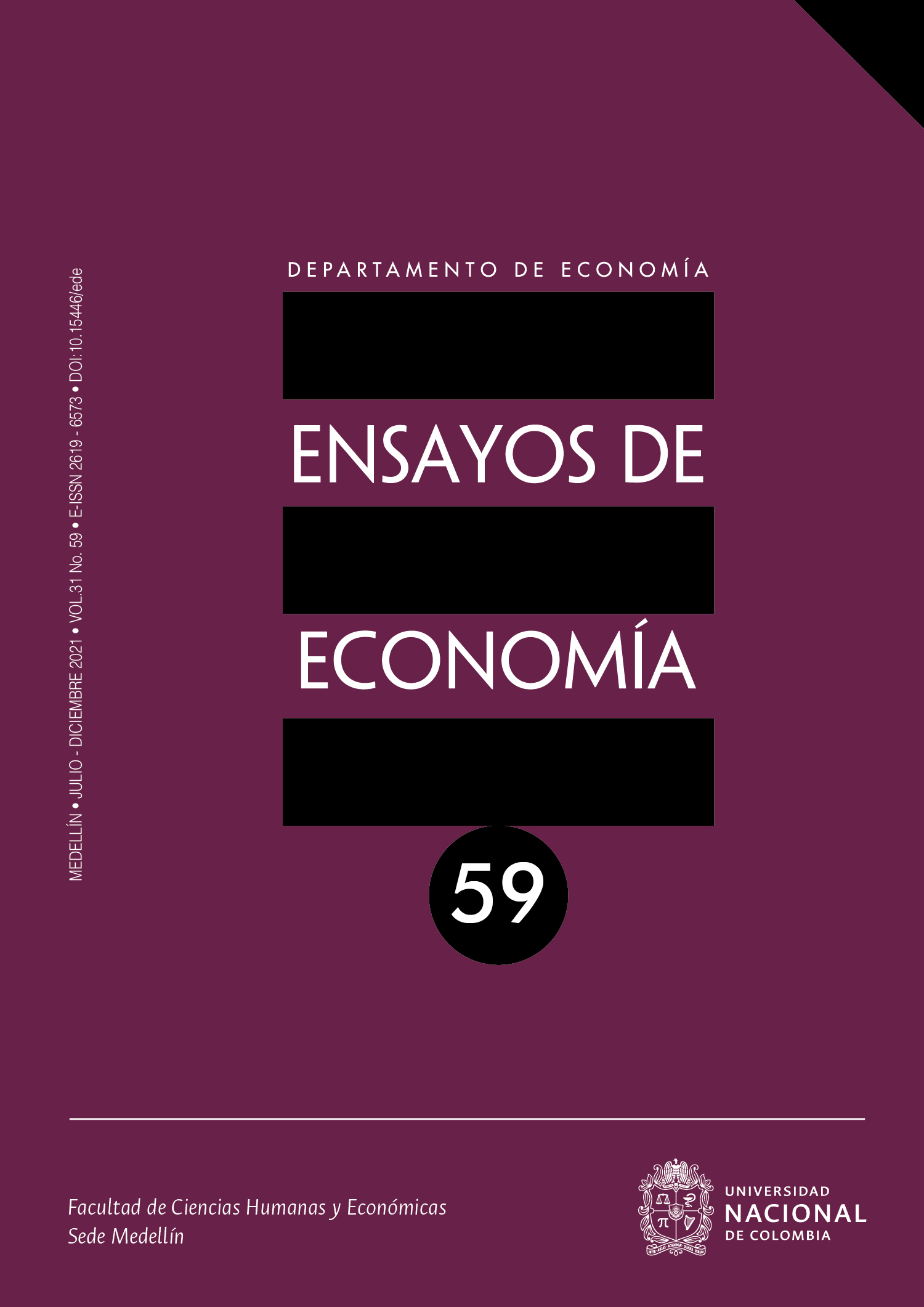Estimación de la función de bienestar social de Amartya Sen para América Latina
Estimating the Amartya Sen’s Social Welfare Function for Latin America
DOI:
https://doi.org/10.15446/ede.v31n59.88235Palabras clave:
Bienestar, Desigualdad, Crecimiento, Ingreso, América Latina (es)Welfare, Inequality, Growth, Income, Latin America. (en)
Descargas
El presente artículo realiza una serie de aproximaciones empíricas sobre la formulación teórica de la función de bienestar social de Sen (1974), aplicadas al contexto latinoamericano entre 1995 y 2018, para establecer las tendencias de bienestar social en el periodo de análisis. Las estimaciones involucran la formulación original de Sen y su versión generalizada propuesta por Mukhopadhaya (2003a; 2003b). El artículo contribuye —igualmente— a la exploración de las relaciones de largo plazo entre el bienestar, la desigualdad y el ingreso a través del análisis de cointegración de datos de panel. Los resultados indican la existencia de relaciones de largo plazo entre estas variables, una elasticidad ligeramente mayor sobre el bienestar desde la distribución del ingreso que desde el crecimiento económico, mientras que en el corto plazo el bienestar solamente es explicado a través de este último. Finalmente, para los países latinoamericanos se establece su posicionamiento a partir de los niveles de bienestar. Las predicciones del modelo econométrico planteado coinciden —en términos de comportamiento y posición comparativa del bienestar social entre países en relación— con la estimación del planteamiento original de Sen aplicado a América Latina.
This article carries out a series of empiric approximations of the theoretical formula for Sen’s (1974) social welfare function, applied to the Latin American context between 1985 and 2018 to establish social welfare tendencies in the period analyzed. The estimates involve Sen’s original formula and its generalized version proposed by Mukhopadhaya (2003a; 2003b). The article contributes – likewise- to the exploration of the long-term relations between welfare, inequality and income through a co-integration analysis of panel data. The results point to the existence of long-term relationships between these variables, a slightly greater elasticity for social welfare when based on income distribution than when based on economic growth, while in the short-term social welfare is only explained through the latter. Finally, positioning for Latin American countries is established through their levels of social welfare. Forecasts made with the proposed econometric model coincide – in terms of behavior and comparative social welfare position among the countries listed – with the estimate from the original Sen approach applied to Latin America.
Referencias
Anand, S. & Harris, C. (1994). Choosing a Welfare Indicator. The American Economic Review, 84(2), 226-231. https://www.jstor.org/stable/2117834?seq=1
Arrow, K. J. (1963). Social Choice and Individual Values. Wiley. http://catalogo.econo.unlp.edu.ar/meran/opac-detail.pl?id1=5702#.YCXXu3lOnIU
Banco Mundial. (s. f.). World Development Indicators. Consultado el 10 de enero de 2020. https://databank.worldbank.org/source/world-development-indicators
Blackorby, C., Bossert, W., & Donaldson, D. (2002). Chapter 11. Utilitarianism and the Theory of Justice. En K. J. Arrow, A. K. Sen & K. Suzumura (eds.), Handbook of Social Choice and Welfare Volume 1 (pp. 542-596). North Holland. https://doi.org/10.1016/S1574-0110(02)80015-7
Bentham, J. (2000) An Introduction to the Principles of Morals and Legislation. Batoche Books. (original publicado en 1781). https://socialsciences.mcmaster.ca/econ/ugcm/3ll3/bentham/morals.pdf
Baluch, M. U. H. & Razi, S. (2007). Social Welfare Measurement in Pakistan: An Ordinal and Cardinal Approach. Pakistan Economic and Social Review, 45(1), 55-88. https://www.jstor.org/stable/25825304?seq=1
Bergson, A. (1938). A Reformulation of Certain Aspects of Welfare Economics, The Quarterly Journal of Economics, 52(2), 310-334. https://doi.org/10.2307/1881737
Berman, Y., Ben-Jacob, E., & Shapira, Y. (2016). The Dynamics of Wealth Inequality and the Effect of Income Distribution. PLoS ONE, 11(4), 1-19. https://doi.org/10.1371/journal.pone.0154196
Berrebi, Z. M., & Silber, J. (1987). Regional Differences and the Components of Growth and Inequality Change. Economics Letters, 25(3), 295-98. https://doi.org/10.1016/0165-1765(87)90231-X
Bishop, J. A., Chakraborti, S., & Thistle, P. D. (2009). Practitioner's Corner: An Asymptotically Distribution‐Free Test for Sen's Welfare Index. Oxford Bulletin of Economics & Statistics, 52(1), 105-113. https://doi.org/10.1111/j.1468-0084.1990.mp52001008.x
Chancel, L., Hough, A., & Voituriez, T. (2017). Reducing Inequalities within Countries: Assessing the Potential of the Sustainable Development Goals. Global Policy, 9(1), 5-16. https://doi.org/10.1111/1758-5899.12511
Cobham, A., Schlögl, L., & Sumner, A. (2016). Inequality and the Tails: the Palma Proposition and Ratio. Global Policy, 7(1), 26-36. https://doi.org/10.1111/1758-5899.12320
Driscoll, J. C., & Kraay, A. C. (1998). Consistent Covariance Matrix Estimation with Spatially Dependent Panel Data. Review of Economics and Statistics, 80(4), 549-560. https://www.jstor.org/stable/2646837
Engle, R. F., & Granger, C. W. J. (1987) Co-Integration and Error Correction: Representation, Estimation, and Testing. Econometrica, 55(2), 251-276. https://doi.org/10.2307/1913236
Gasparini, L., & Weinschelbaum, F. (1991). Medidas de desigualdad en la distribución del ingreso: algunos ejercicios de aplicación. Económica, 37(1), 31-44. http://sedici.unlp.edu.ar/handle/10915/9352
Gasparini, L., & Sosa Escudero, W. (2001). Assessing Aggregate Welfare: Growth and Inequality in Argentina. Cuadernos de Economía, 38(113), 49-71. http://dx.doi.org/10.4067/S0717-68212001011300002
Gründler, K., & Köllner, S. (2017). Determinants of Governmental Redistribution: Income Distribution, Development Levels, and The Role of Perceptions. Journal of Comparative Economics, 45(4), 930-962. https://doi.org/10.1016/j.jce.2016.10.007
Hoechle, D. (2007). Robust Standard Errors for Panel Regressions, with Cross-Sectional Dependence. The Stata Journal, 7(3), 281-312. https://doi.org/10.1177/1536867X0700700301
Im, K. S., Pesaran, M. H., & Shin, Y. (2003). Testing for Unit Roots in Heterogeneous Panels. Journal of Econometrics, 115(1), 53–74. https://doi.org/10.1016/S0304-4076(03)00092-7
Karakitsos, E., & Varnavides, L. (2014). Maritime Economics: A macroeconomic Approach. Springer.
Kao, C. (1999). Spurious Regression and Residual-Based Tests for Cointegration in Panel Data. Journal of Econometrics, 90(1), 1-44. https://doi.org/10.1016/S0304-4076(98)00023-2
Levin, A., Lin, C. F., & Chu, C. S. J. (2002). Unit Root Tests in Panel Data: Asymptotic and Finite-Sample Properties. Journal of Econometrics, 108(1), 1-24. https://doi.org/10.1016/S0304-4076(01)00098-7
Madsen, E. (2005). Estimating Cointegrating Relations from a Cross Section. The Econometrics Journal, 8(3), 380–405. https://doi.org/10.1111/j.1368-423X.2005.00170.x
McCoskey, S., & Kao, C. (1998). A Residual-based Test of the Null of Cointegration in Panel Data. Econometric Reviews, 17(1), 57-84. https://doi.org/10.1080/07474939808800403
McGillivray, M., & Markova, N. (2010). Global Inequality in Well-being Dimensions. The Journal of Development Studies, 46(2), 371-378. https://doi.org/10.1080/00220380903033280
Milanovic, B. (2013). Global Income Inequality in Numbers: In History and Now. Global Policy, 4(2), 198-208. https://doi.org/10.1111/1758-5899.12032
Mukhopadhaya, P. (2001a). A Generalized Social Welfare Function, Its Decomposition and Application [NUS Working Paper 0119]. http://www.fas.nus.edu.sg/ecs/pub/wp/wp0119.pdf
Mukhopadhaya, P. (2001b). A Generalized Social Welfare Function and its Disaggregation by Components of Income: The Method and Application [NUS Working Paper 0121]. http://www.fas.nus.edu.sg/ecs/pub/wp/wp0121.pdf
Mukhopadhaya, P. (2003a). A Generalized Social Welfare Function and Its Disaggregation by Components of Income: The method and applications. En J. Bishop & Y. Amiel (eds.), Inequality, Welfare and Poverty: Theory and Measurement (Research on Economic Inequality Volume 9 (pp. 245-264). Emerald Publishing Limited. https://doi.org/10.1016/S1049-2585(03)09012-4
Mukhopadhaya, P. (2003b). The Ordinal and Cardinal Judgment of Social Welfare Change in Singapore, 1982-99. The Developing Economies, 61(1), 65-87. https://doi.org/10.1111/j.1746-1049.2003.tb00930.x
Mukhopadhaya, P. (2014). Income Inequality in Singapore. Routledge.
Mill, J. S. (2001). Utilitarianism. Batoche Books. (original publicado en 1863). https://socialsciences.mcmaster.ca/econ/ugcm/3ll3/mill/utilitarianism.pdf
Ndamsa, T. D., Njang, G., & Baye, F. M. (2020). Social Welfare Consequences of the Radius of Employment Decency. Athens Journal of Business & Economics, 6(3). 211-238. https://doi.org/10.30958/ajbe.6-3-3
Pedroni, P. (1999). Critical Values for Cointegration Tests in Heterogeneous Panels with Multiple Regressors. Oxford Bulletin of Economics and Statistics, 61(1), 653-670. https://onlinelibrary.wiley.com/doi/abs/10.1111/1468-0084.0610s1653
Piketty, T. (2013). El capital en siglo XXI. Fondo de Cultura Económica.
Programa de las Naciones Unidas para el Desarrollo (PNUD). (2019). Panorama general Informe sobre Desarrollo Humano 2019. Más allá del ingreso, más allá de los promedios, más allá del presente: desigualdades del desarrollo humano en el siglo XXI. http://hdr.undp.org/sites/default/files/hdr_2019_overview_-_spanish.pdf
Programa de las Naciones Unidas para el Desarrollo (PNUD). (s. f.). Human Development Data (1990-2018). Consultado el 11 de mayo de 2020. http://hdr.undp.org/en/data
Roberts, K. W. S. (1980). Possibility Theorems with Interpersonally Comparable Welfare Levels. Review of Economic Studies, 47(2), 409-420. https://doi.org/10.2307/2297001
Tomaszewicz, L., & Trębska, J. (2015). The Role of General Government in the Income Redistribution in the Polish Economy. Journal of International Studies, 8(2), 83-100. https://doi.org/10.14254/2071-8330.2015/8-2/8
Sen, A. K. (1974). Informational Bases of Alternative Welfare Approaches: Aggregation of Income Distribution. Journal of Public Economics, 3(4), 387-403. https://doi.org/10.1016/0047-2727(74)90006-1
Sen, A. K. (1976) Real National Income. The Review of Economic Studies, 43(1), 19-39. https://doi.org/10.2307/2296597
Wooldridge, J. M. (2001). Econometric Analysis of Cross Section and Panel Data. The MIT Press.
Zhang, L. (2007) Political Economy of Income Distribution Dynamics. Journal of Development Economics, 87(1), 119-139. https://doi.org/10.1016/j.jdeveco.2007.11.005
Cómo citar
APA
ACM
ACS
ABNT
Chicago
Harvard
IEEE
MLA
Turabian
Vancouver
Descargar cita
Licencia
Derechos de autor 2021 Ensayos de Economía

Esta obra está bajo una licencia internacional Creative Commons Atribución-NoComercial-SinDerivadas 4.0.
Se autoriza la reproducción sin ánimo de lucro de los materiales, citando la fuente.


























